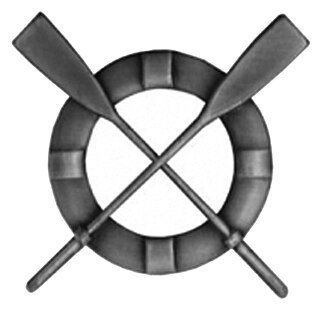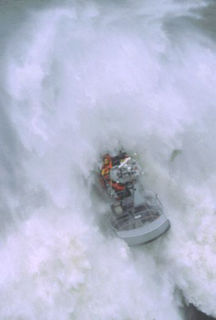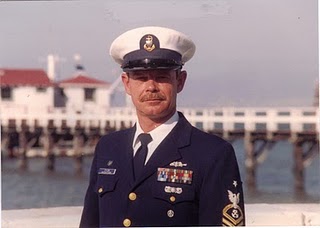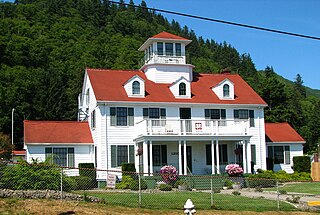
The United States Life-Saving Service was a United States government agency that grew out of private and local humanitarian efforts to save the lives of shipwrecked mariners and passengers. It began in 1848 and ultimately merged with the Revenue Cutter Service to form the United States Coast Guard in 1915.

The Virginia Beach Surf & Rescue Museum honors and preserves the history of Virginia's maritime heritage, coastal communities, the United States Lifesaving Service, and the United States Coast Guard along the Atlantic coast.

Surfmen was the terminology used to describe members of the United States Lifesaving Service. It is also currently the highest qualification in the United States Coast Guard for small boat operations. Coast Guard Surfmen are rated to operate the 47-foot Motor Lifeboat in its most extreme operating conditions after undergoing training at the National Motor Lifeboat School.

A Lyle gun was a line thrower powered by a short-barrelled cannon. It was invented by Captain David A. Lyle, US Army, a graduate of West Point and the Massachusetts Institute of Technology and were used from the late 19th century to 1952, when they were replaced by rockets for throwing lines.

Joshua James was an American sea captain and a U.S. Life–Saving Station keeper. He was a famous and celebrated commander of civilian life-saving crews in the 19th century, credited with saving over 500 lives from the age of about 15 when he first associated himself with the Massachusetts Humane Society until his death at the age of 75 while on duty with the United States Life–Saving Service. During his lifetime he was honored with the highest medals of the Humane Society and the United States. His father, mother, brothers, wife, and son were also lifesavers in their own right.

Pea Island Life-Saving Station was a life-saving station on Pea Island, on the Outer Banks of North Carolina. It was the first life-saving station in the country to have an all-black crew, and it was the first in the nation to have a black man, Richard Etheridge, as commanding officer. On August 3, 2012, the second of the Coast Guard's 154-foot Sentinel-Class Cutters, USCGC Richard Etheridge (WPC-1102), was commissioned in his honor.

The boatswain's mate is a position in the United States Coast Guard. A boatswain's mate is a versatile role, with those holding the role expected to be capable of nearly any job in a Coast Guard vessel. The tasks include deck maintenance, navigation duties, and navigation. They can also take the helm of a ship when needed.
A rescue lifeboat is a boat rescue craft which is used to attend a vessel in distress, or its survivors, to rescue crew and passengers. It can be hand pulled, sail powered or powered by an engine. Lifeboats may be rigid, inflatable or rigid-inflatable combination-hulled vessels.

United States Coast Guard Station Cape Disappointment, situated near Cape Disappointment, Washington, at the mouth of the Columbia River, is the largest United States Coast Guard search and rescue station on the Northwest Coast, with 50 crewmembers assigned. Cape Disappointment Station is also the site of the oldest search and rescue station within the Thirteenth Coast Guard District. The station's Area of Responsibility reaches from Ocean Park on the Washington Coast south to Tillamook Head on the Oregon Coast.

The 47-foot MLB is the standard lifeboat of the United States Coast Guard (USCG). The 47′ MLB is the successor to the 44′ MLB.

United States Coast Guard Station Manomet Point was a United States Life-Saving Service station – and later a United States Coast Guard station – located on Manomet Point in Manomet, Massachusetts. The station was a sub-unit of Sector Southeast New England.

The 30 foot surf rescue boat is a lifeboat that the United States Coast Guard has used in recent years. The 30' long boat is designated the surf rescue boat (SRB) and was introduced in 1983.

The 44-foot motor lifeboat was the standard workhorse of the United States Coast Guard (USCG) rescue boat fleet. The 44′ MLB has been replaced by the 47′ MLB. The boats are powered by twin diesel engines, each powering a separate propeller. The propellers are protected by the hull to help prevent them being damaged if the boat runs aground. The boats have air-tight compartments forward and aft of the steering station. The aft compartment is designed to hold litters to strap in injured people, while the forward compartment holds uninjured rescued.

The Humboldt Bay Life-Saving Station was originally built in November 1878 on the north side of the entrance to Humboldt Bay in northern California, United States near Eureka, adjacent to the site of the first Humboldt Harbor Light (1856–1892). Rebuilt in 1936 with marine railways to launch rescue surfboats, the historic facility was placed on the National Register of Historic Places on October 30, 1979. The station continues to function as an important asset of the United States Coast Guard in the Coast Guard Group/Air Station Humboldt Bay.

Richard Dixon was the coxswain of a 44-foot Motor Lifeboat, on the July 4th weekend of 1980, when his skill and daring enabled him to rescue stricken pleasure boat crew off Tillamook Bay, Oregon. During the first incident a 58-foot yacht was in distress in the aftermath of hurricane Celia, and needed to seek sheltered waters, but wave conditions seemed likely to batter it apart if it tried to use the narrow entrance between two stone jetties to enter Tillamook Bay's harbor. Dixon and the coxswain of another motor lifeboat maneuvered beside the yacht, to absorb some of the wave energy as it entered harbor.

Coast Guard Station Tillamook Bay is an active duty installation of the United States Coast Guard located in Garibaldi, Oregon, as well as a nationally recognized historic site. A station has been operating in Tillamook Bay since 1908. The station was opened by the United States Life-saving Service a precursor agency to the Coast Guard. The current station has been in continuous operation since 1942.

The United States Coast Guard operates four 52-foot Motor Lifeboats (MLBs), which supplement its fleet of 227 47-foot Motor Lifeboats. These vessels were built in the late 1950s and early 1960s, and displace 32 tons. The four vessels are all stationed in the Pacific Northwest.

Daniel Webster Cluff was a United States Coast Guard officer who led one of the U.S. Coast Guard’s largest small-boat rescue operations in the midst of a New England winter storm on February 18 through 19, 1952, as Chatham Lifeboat Station’s officer-in-charge. Warrant Officer Cluff’s expertise in small-boat life-saving operations and confidence in his men's abilities resulted in Coast Guard Motor Lifeboat CG 36500 crew’s rescue of thirty-two survivors from the stern section of SS Pendleton “only minutes before it capsized.”

Coast Guard Station Oak Island referred to locally as the Oak Island Coast Guard Station (OICGS) is located in the Town of Caswell Beach on Oak Island in Brunswick County, North Carolina. A part of the Cape Fear region, the station is in the United States Coast Guard 5th District which is charged with ensuring the safety and security of the oceans, coastal areas, and marine transportation system within the Mid-Atlantic Region. The district encompasses some 156,000 square miles of ocean, bays, rivers, wetlands and tidal marshes, geographic waterways, several major mid-Atlantic ports, and the Nation’s capital. They also patrol the mouth of the Cape Fear River in Southport, North Carolina and the Intracoastal Waterway (ICW)

U.S. Coast Guard Station Golden Gate is a U.S. Coast Guard station in Sausalito, California. It falls under Coast Guard Sector San Francisco in the U.S.C.G.'s District Eleven.



















